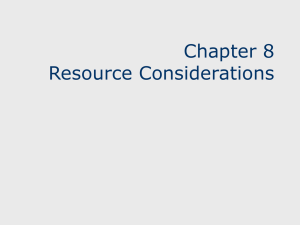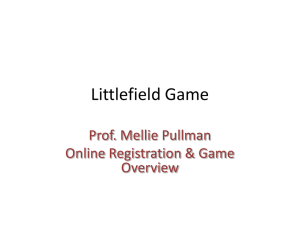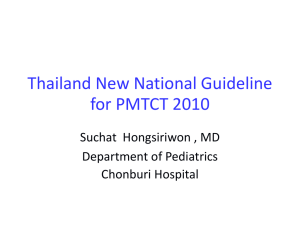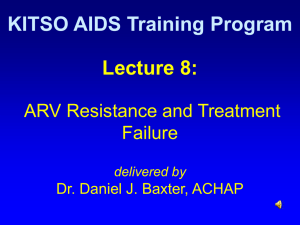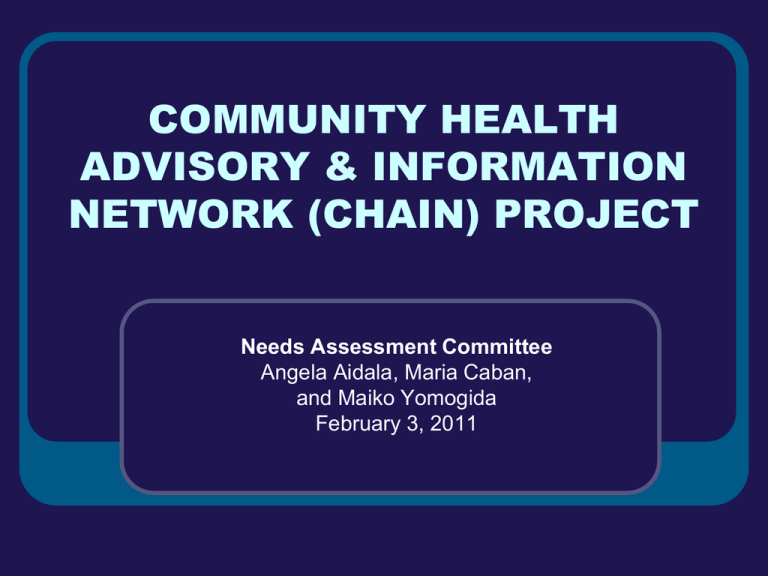
COMMUNITY HEALTH
ADVISORY & INFORMATION
NETWORK (CHAIN) PROJECT
Needs Assessment Committee
Angela Aidala, Maria Caban,
and Maiko Yomogida
February 3, 2011
Introduction: Planning Questions
What services do HIV+ persons need?
Where do they go for care?
What are their unmet needs/ service gaps?
What populations are underserved?
What works well, what doesn’t work?
What are the barriers and access issues?
WHERE SHOULD WE PUT OUR MONEY?
CHAIN PROJECT GOALS
To provide a profile of PLWH/A in New York
City and the Tri-County Region
To assess the system of HIV care – both
health and social services – from the
perspective of people living with HIV
To report on unmet needs, service utilization
trends, and outcomes to the Planning
Council and its Committees
History of CHAIN
Initially developed in 1993 as one of the Planning
Council’s evaluation resources
Contract with Columbia University School of
Public Health
CHAIN has recruited 4 cohorts of PLWH/A
-
NYC I (1994-2002, n=968)
NYC II (2002-present, n=1114)
Tri-County I (2001-2007, n=482)
Tri-County II (2008-present, n=360)
A Technical Review Team (TRT) which includes
representatives of the Planning Council, Public
Health Solutions, NYCDOHMH and WDOH
oversees CHAIN
17 Year Highlights (1994 -2011)
2000+ PLWHA completed ave. 4+ interviews
850-item questionnaire
120 trained interviewers
150+ reports
Multiple presentations to Planning Council,
Council Committees, PPG, HAWG, provider
and community groups, professional
conferences
Steps in the Process
Develop a research strategy
Consult with stakeholders
Develop research infrastructure
Implement strategy
Analyze & report on research findings
Re-evaluate strategy
Consult with stakeholders
Selecting CHAIN Participants
A 2-Step Process
Designed to enroll representative samples
1st step: random selection of service sites
from listing of all agencies serving HIV clients
-- Medical and Social Service
-- All Boroughs (or Counties)
-- RW Funding vs. non RW
2nd step: agency staff help with random
selection of clients
-- Random selection from client rosters
-- Sequential enrollment
Recruiting CHAIN Participants
Unconnected to Care
NYC CHAIN includes small samples of
PLWHA unconnected to care
Unconnected: Aware, no medical care, no
case management for 6+months
•
•
•
•
Referrals from CHAIN agency recruited participants
Accompany Outreach Workers
Open recruitment and screening in street and
community settings
1994 (n=48) 1998 (n=24) 2002 (n=25)
Comparison of CHAIN Participants with
Surveillance & RW Encounter Data
NYC Persons Living
with HIV,
as of 6/30/03 11
2
CHAIN
2002 Cohort
6/2002-6/2004
Female
Male
Female
Male
Female
Male33
10,104
(35%)
18,995
(65%)
10,765
(39%)
16,962
(61%)
278
(40%)
415
(60%)
White
8%
30%
9%
8%
6%
10%
Black
58%
36%
53%
53%
62%
47%
Latino
31%
30%
37%
37%
31%
41%
Other
3%
4%
2%
2%
<1% (1)
2%
Total N
1
Ryan White CARE
Act Encounters,
3/2001 - 2/2002 22
HIV Epidemiology Program DOHMH
HIV CARE Services.
Cohort composition closely tracks surveillance data/ RW client data
Collecting Information by
Speaking with PLWHA
Comprehensive in-person 2hr+ interview
Follow-up interviews approx. yearly
Interviews in homes or agency settings
Community-based interviewing team
$35 incentive for every interview + referral
resource
Strong community support with 80% - 90%
follow-up interview completion rate
Topics Covered
Current health & mental health status
Sociodemographic background
Family life, housing, work, economic resources
Sexual behaviors
Outlook on life, stress, stigma
Substance use behaviors
History of medical and social services
Utilization of medical and social services
Medication use and adherence
Service needs, satisfaction with services, barriers
Social networks, social support
Quality of life
Analyze & Report
Prepare data for analysis
Work with Council & staff to define topics
Consult with stakeholders
- What emerging issues should be investigated?
- What subgroup comparisons?
Prepare draft of reports and get feedback
Disseminate final reports
Some ways of classifying PLWH/A
Gender
- Male / female / transgender
Race / Ethnicity
- White / Black / Latino / Other
HIV risk exposure group
- MSM / PDU / MSM + PDU / Hetero & Other
Clinical indicators
- Viral load undetectable/ detectable
Age
- 20-34 yrs old / 35-49 yrs / 50+ yrs
Geography
- Bronx, Brooklyn, Manhattan, Queens, Staten Island
Types of Analyses
Descriptive (rates, percentages, trends, mapping)
Analytical
-- Are there group differences?
-- Do certain models of care, interventions, or policies
make a difference?
Multivariate analyses – considering the effects of
many factors taken together
Assessing the System of Care
Conduct studies to examine:
Medical care, health, mental health, QOL outcomes
for PLWHA
Trend data – tracking change over time
Individual factors associated with outcomes
Service utilization associated with outcomes
Systemic factors associated with outcomes
Key resource for needs assessment – can show
service system strengths and weaknesses
Outcome Measures
Appropriate medical care
ARV and HAART utilization & adherence
T-cell changes, viral load suppression
Resolution of service need
Health and mental health functioning
Reduction of sex and drug risk behaviors
Mortality
CHAIN Service Needs and
Utilization: NYC Summary
NYCDOH took lead in defining revised set of
service domains, needs and utilization measures
“Need” includes those currently using service
“Gap” = % without adequate service utilization
among those with need for service
Minor differences in need definition between TriCounty and NYC
Compare 2006-2009 with earlier interview period
2001-2006
What is a Service Gap?
The difference between the “need” for service,
and the receipt of service
Need may be “subjective,” in that client explicitly
wants service (AKA “demand”)
--Ex: “In the last 6 months, have you had a problem or
needed assistance with housing?”
Need may be “objective,” in that client’s
circumstances suggest a need for a service,
even if client doesn’t demand it
-- Ex: Client has had at least one episode of homelessness,
being doubled up, or being unstably housed in past 6 mo.
Domain: Ambulatory Health Care
Service : HIV Primary Care
Who Needs the Service?
All Individuals living with HIV/AIDS
Measure of Adequate Utilization
One or more visits to HIV Primary Care
Physician in last six months
19
Trends in HIV Primary Care
Adequate Utilization
Need for Service
Always 100%
Domain: Ambulatory Health Care
Service : ARV Treatment Support
Who Needs the Service?
1. CD4 count< 200 & not on ARV
2. Not completely adherent to ARV meds
or
3. Receiving support services for ARV meds
Measure of Adequate Utilization
Receiving support services for taking ARV’s
from professional providers
Trends in ARV Treatment Support
Need for Service
Adequate Utilization
Domain: Case Management
Service : Social Service C.M.
Who Needs the Service?
1. Poor mental health score on standardized measure
2. In the last 6 months had an inpatient, emergency room or
mobile unit visit for psychiatric or mental health
3. Being homeless or in unstable housing in the last 6 months
4. During past year used cocaine, crack or heroin, OR
5. During past 6 months heavy or problem drinking
Measure of Adequate Utilization
A case manager did one or more of the following in last 6 months:
-Revising or developing a plan for dealing with needs,
-Referrals for social services,
-Help filling out forms for benefits or entitlements
Trends in Social Service C.M.
Need for Service
Adequate Utilization
Domain: Case Management
Service : Medical C.M.
Who Needs the Service?
1. No HIV primary care in the last 6 months
2. Stopped going or no visit to provider in the last 6 months
3. Missed more than one appointment in the last 6 months
4. No CD4 or VL test in the past 6 months, OR
5. Had any of the above problems at prior interviews AND had a
case manager helped in getting or referring for medical
services in the last 6 months
Measure of Adequate Utilization
During the last 6 months a case manager helped in getting or
referring for medical services
Trends in Medical C.M.
Need for Service
Adequate Utilization
Domain: Mental Health
Service : Professional Mental Health
Services
Who Needs the Service?
1. Poor mental health score on standard measure
2. In the last 6 month had an inpatient, emergency room or mobile
unit visit for psychiatric or mental health, or
3. In the last 6 months received counseling from a mental health
professional - psychiatrist, psychologist, therapist, or clinical
social worker
Measure of Adequate Utilization
In the last 6 months received counseling from a mental health care
professional or clinical social worker
Trends in Mental Health Services
Need for Service
Adequate Utilization
Service: Alcohol or Drug Treatment
Who Needs the Service?
1. During past year used cocaine, crack or heroin,
2. During past 6 months heavy or problem drinking, or
3. Reported receiving drug or alcohol treatment was
important
Measure of Adequate Utilization
In last 6 months received any form of treatment for
alcohol or drug use, including AA/NA
Trends in Alcohol or Drug Treatment
Need for Service
Adequate Utilization
Need
Adequate Utilization
HOUSING
(1) Homeless or unstably housed past
six months OR (2) facing eviction or
urgent need to move without resources
to secure adequate housing past six
Permanent
months OR (3) received housing
Housing
assistance past six months that resulted
in resolution of need for permanent
housing or great deal progress toward
resolution
Received housing assistance
past six months that resulted in
resolution of need for
permanent housing or great
deal of progress toward
resolution
FOOD
(1) Did not have enough money in the
household for food once in a while to
very often in the last six months OR (2)
Food went for a while day without anything to
Services eat in the last 30 days OR (3) receiving
food stamps OR (4) do not have
unlimited access to a kitchen
Received one or more of the
following services in the last
six months: (1) Meals provided
in a group setting, (2) prepared
meals delivered to home, (3)
received food voucher or food
from a food pantry
Food and Housing Services
Need for Service
2006-2009
Adequate Utilization
The Value of CHAIN
Patterns and proportions we see in the sample
can be used as estimates for the broader HIV+
population
Over time data can show changes in needs as
well as effects of services and system wide
interventions
Provides broad range of evidence about
service needs and outcomes from the point of
view of persons living with HIV/AIDS
ACKNOWLEDGMENTS
A Technical Review Team (TRT) provides oversight for the CHAIN Project.
In addition to Peter Messeri, PhD, Angela Aidala, PhD, Maria Caban, MA,
Melissa White, MSSW, and Maiko Yomogida of Columbia University’s
Mailman School of Public Health, TRT members include Mary Ann
Chiasson, DrPH, (Chair), Roberta Scheinmann, MPH, Public Health
Solutions, Inc.; Jan Carl Park, MPA, Nina Rothschild, DrPH, Office of AIDS
Policy and Community Planning; Mary Irvine, DrPH, Yoran Grant, PhD
MPH, Daniel Weglein, MD, and Fabienne Laraque, MD MPH, Office of
Evaluation and Quality Assurance; Ellen Wiewel, PhD, HIV Epidemiology
and Field Services Program and JoAnn Hilger, Director, Ryan White
Services, New York City Department of Health and Mental Hygiene; Julie
Lehane, PhD, and Tom Petro, Westchester County Department of Health;,
and Gregory Cruz.
CHAIN reports are solely the responsibility of the researchers and do not
necessarily represent the official views of the U.S. Health Resources and
Services Administration, the City of New York, or Public Health Solutions.


